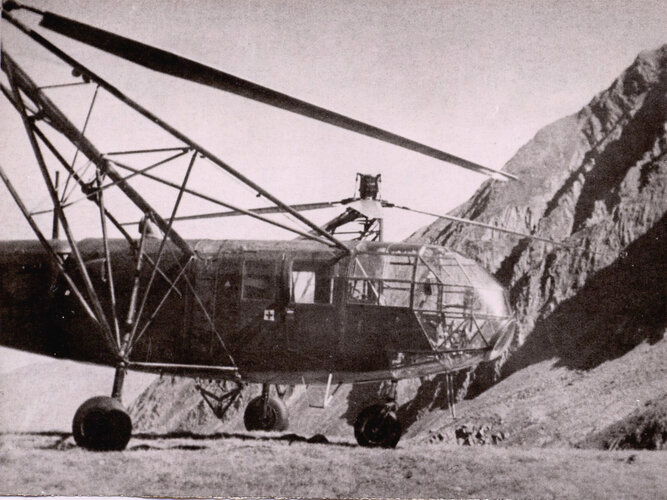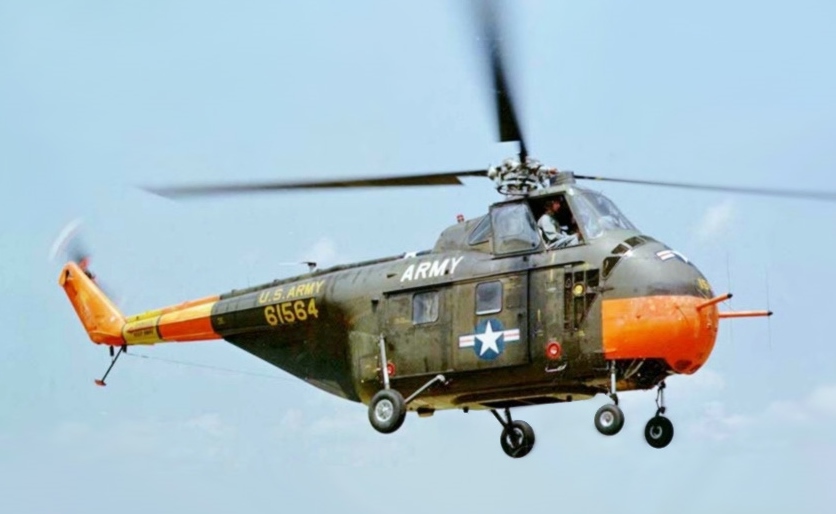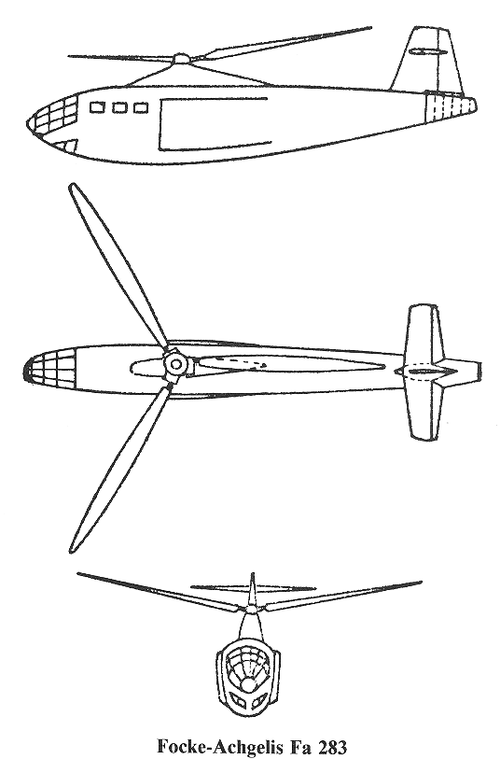The "heavy" advanced helicopters of the 1950s could very well have been in WWII.
This is not crazy talk.
The H-34 Choctaw had a single R-1830 radial powering it -- the same engine that powered the:
DC-3/C-47
B-17
SBD Dauntless
Biggest issue is that helicopters were very much in the "Experimental" stage.
The R-4 was in limited use; with the R-5 coming along in 1945 when the war ended:
https://en.wikipedia.org/wiki/Sikorsky_H-5
That one had a single 450 hp R-985 radial.
The Germans had the Fa-223 Drache; which had a single 1,000 hp engine powering twin rotors. It oculd carry cargo loads up to 2,200 lb.
The Drache was to be developed in five versions originally:
Fa-223A ASW helicopter with two 250 kg bombs or depth charges.
Fa-223B observation/reconnaissance helicopter.
Fa-223C search and rescue helicopter.
Fa-223D transport helicopter.
Fa-223E dual control pilot training helicopter.
In the end, it was decided to make just one multi-purpose variant with different attachments.
The first Laupheim built Fa-223E-0 (V11) flew on June 21, 1943. The V11 exhibited its carrying ability by lifting such items as Fieseler Storch observation aircraft, an Me-109 fuselage, a one ton engine, and a Volkswagen military staff car.
Only about 20 Fa-223s were built; and one of the prototypes V16, was used by the German Mountain Warfare school over 83 flights, with a flying time of 20 hours to transport artillery guns and mountain troops.
Basically, during these tests; it:
A.) Lifted 1,100 pounds to a remote site at 6,500 ft elevation after a seven minute flight -- something that would need 20 men and nearly two days of strenuous climbing to accomplish conventionally.
B.) Lifted a mountain howitzer and ammunition via cable to a mountain peak.
C.) Carried as many as 12 men (4 inside cabin and 8 on tractor seats on outriggers)
When the tests ended on 5 October 1944, the Mountain Warfare school enthuastically endorsed the Fa-223.
On 11 October 1944, the RLM ordered all work to stop, in order to transfer all Focke-Achgelis personnel to Messerschmitt to assist in Me-262 production.
In December 1944, the RLM changed it's mind and decided that 400 a month were to be built at a new factory in Tempelhof Airport at Berlin. This, despite all tooling had been previously blown up by the USAAF in bombing raids.
Tempelhof actually did build one Fa-233E and it's story was pretty crazy.
It was delivered to the Luftwaffe and by "Order of the Fuhrer" on February 25, 1945, ordered to fly to Danzig.
It took off from Tempelhof the next morning to proceed on its mission. Due to dodging storms, Allied bombing attacks, advancing allied forces, and having to search for fuel, the helicopter did not arrive on the outskirts of Danzing until the evening of March 5th.
There, because of advancing Soviet forces, it was now impossible to fly into the center of Danzing as ordered. While awaiting orders on where to proceed, the crew got word that a fighter pilot had gotten lost in a snowstorm and had made a crash landing. Lt. Gerstenhauer took off in the Fa-223 and proceeded to search the area. The helicopter crew spotted the downed Me-109 with the injured pilot still in the cockpit. They rescued him and flew him back to the base for medical attention. By this time, Danzing was falling to the Russians, and the Fa-223's crew took off to try to reach a safer haven. Fuel was still a problem and when they did find a fuel stockpile, they realized that the Allies push had captured or destroyed all the friendly airfields along their projected route. After topping the tanks off, they loaded a 55 gallon drum of gasoline and a hand pump on board, took off and overflew the Soviet forces.
When they finally put down at the German base at Werder, they had flown a total of 1,041 mile on this escape mission. After a rest the ship was flown to Ainring to join Transportstaffel 40, only to be captured by American troops.
One of the survivors was actually flown across the English Channel post-war in September 1945, becoming the first helicopter to cross the channel.
With all that said...
There was nothing technically preventing a 10 (or more) passenger helicopter from being developed in WWII; the engines were available (1,000 hp radials or inlines) and construction techniques of the time were up to making the helicopters. (either stressed skin or aluminum pole frames).
You could have used the glider manufacturing base, albeit with some bleed off of engines and aluminum from other programs.
The short ranges of helicopters aren't a drawback -- airborne troops were never used to their maximum theoretical airdrop radiuses other than the early TORCH airdrops.
And unlike troop carriers/gliders; you can use the helicopters for other things after the airborne landing. That was a sore subject with Army leadership regarding Airborne Divisions in 1945; from AFRA Reel A1372 Frame 448:
9 Aug 1944
Memorandum to Marshall (Chief of Staff)
Subj: "Maximum Employment of Troop Carrier Units"
"Our troop carrier force in the United Kingdom, aggregating with associated services some 37,000 men, was employed for only five (5) days in the airborne phase of OVERLORD, subsequently carried out one (1) four-day resupply mission, and was then returned to theater training. There are indications that this force will soon be employed again tactically. Such employment with specially trained airborne forces apparently will continue to be intermittent."
800 x C-47s = 1,600 x R-1830s, 1,600 skilled pilots, 800 navigators, 800 radio operators, and 30,000 ground maintenance troops and you....can't really do much with them.
Whereas, if you halved the C-47 force; you suddenly get:
800 x R-1830s, 800 pilots free to equip hypothetical 12,000 to 15,000 lb Gross Weight helicopters carrying 14 men.
Unlike gliders; you can recycle and reuse them after operations; and unlike troop carriers; you can actually use them tactically for various missions (artillery spotting, casualty evac, etc) with the ground forces
This is not crazy talk.
The H-34 Choctaw had a single R-1830 radial powering it -- the same engine that powered the:
DC-3/C-47
B-17
SBD Dauntless
Biggest issue is that helicopters were very much in the "Experimental" stage.
The R-4 was in limited use; with the R-5 coming along in 1945 when the war ended:
https://en.wikipedia.org/wiki/Sikorsky_H-5
That one had a single 450 hp R-985 radial.
The Germans had the Fa-223 Drache; which had a single 1,000 hp engine powering twin rotors. It oculd carry cargo loads up to 2,200 lb.
The Drache was to be developed in five versions originally:
Fa-223A ASW helicopter with two 250 kg bombs or depth charges.
Fa-223B observation/reconnaissance helicopter.
Fa-223C search and rescue helicopter.
Fa-223D transport helicopter.
Fa-223E dual control pilot training helicopter.
In the end, it was decided to make just one multi-purpose variant with different attachments.
The first Laupheim built Fa-223E-0 (V11) flew on June 21, 1943. The V11 exhibited its carrying ability by lifting such items as Fieseler Storch observation aircraft, an Me-109 fuselage, a one ton engine, and a Volkswagen military staff car.
Only about 20 Fa-223s were built; and one of the prototypes V16, was used by the German Mountain Warfare school over 83 flights, with a flying time of 20 hours to transport artillery guns and mountain troops.
Basically, during these tests; it:
A.) Lifted 1,100 pounds to a remote site at 6,500 ft elevation after a seven minute flight -- something that would need 20 men and nearly two days of strenuous climbing to accomplish conventionally.
B.) Lifted a mountain howitzer and ammunition via cable to a mountain peak.
C.) Carried as many as 12 men (4 inside cabin and 8 on tractor seats on outriggers)
When the tests ended on 5 October 1944, the Mountain Warfare school enthuastically endorsed the Fa-223.
On 11 October 1944, the RLM ordered all work to stop, in order to transfer all Focke-Achgelis personnel to Messerschmitt to assist in Me-262 production.
In December 1944, the RLM changed it's mind and decided that 400 a month were to be built at a new factory in Tempelhof Airport at Berlin. This, despite all tooling had been previously blown up by the USAAF in bombing raids.
Tempelhof actually did build one Fa-233E and it's story was pretty crazy.
It was delivered to the Luftwaffe and by "Order of the Fuhrer" on February 25, 1945, ordered to fly to Danzig.
It took off from Tempelhof the next morning to proceed on its mission. Due to dodging storms, Allied bombing attacks, advancing allied forces, and having to search for fuel, the helicopter did not arrive on the outskirts of Danzing until the evening of March 5th.
There, because of advancing Soviet forces, it was now impossible to fly into the center of Danzing as ordered. While awaiting orders on where to proceed, the crew got word that a fighter pilot had gotten lost in a snowstorm and had made a crash landing. Lt. Gerstenhauer took off in the Fa-223 and proceeded to search the area. The helicopter crew spotted the downed Me-109 with the injured pilot still in the cockpit. They rescued him and flew him back to the base for medical attention. By this time, Danzing was falling to the Russians, and the Fa-223's crew took off to try to reach a safer haven. Fuel was still a problem and when they did find a fuel stockpile, they realized that the Allies push had captured or destroyed all the friendly airfields along their projected route. After topping the tanks off, they loaded a 55 gallon drum of gasoline and a hand pump on board, took off and overflew the Soviet forces.
When they finally put down at the German base at Werder, they had flown a total of 1,041 mile on this escape mission. After a rest the ship was flown to Ainring to join Transportstaffel 40, only to be captured by American troops.
One of the survivors was actually flown across the English Channel post-war in September 1945, becoming the first helicopter to cross the channel.
With all that said...
There was nothing technically preventing a 10 (or more) passenger helicopter from being developed in WWII; the engines were available (1,000 hp radials or inlines) and construction techniques of the time were up to making the helicopters. (either stressed skin or aluminum pole frames).
You could have used the glider manufacturing base, albeit with some bleed off of engines and aluminum from other programs.
The short ranges of helicopters aren't a drawback -- airborne troops were never used to their maximum theoretical airdrop radiuses other than the early TORCH airdrops.
And unlike troop carriers/gliders; you can use the helicopters for other things after the airborne landing. That was a sore subject with Army leadership regarding Airborne Divisions in 1945; from AFRA Reel A1372 Frame 448:
9 Aug 1944
Memorandum to Marshall (Chief of Staff)
Subj: "Maximum Employment of Troop Carrier Units"
"Our troop carrier force in the United Kingdom, aggregating with associated services some 37,000 men, was employed for only five (5) days in the airborne phase of OVERLORD, subsequently carried out one (1) four-day resupply mission, and was then returned to theater training. There are indications that this force will soon be employed again tactically. Such employment with specially trained airborne forces apparently will continue to be intermittent."
800 x C-47s = 1,600 x R-1830s, 1,600 skilled pilots, 800 navigators, 800 radio operators, and 30,000 ground maintenance troops and you....can't really do much with them.
Whereas, if you halved the C-47 force; you suddenly get:
800 x R-1830s, 800 pilots free to equip hypothetical 12,000 to 15,000 lb Gross Weight helicopters carrying 14 men.
Unlike gliders; you can recycle and reuse them after operations; and unlike troop carriers; you can actually use them tactically for various missions (artillery spotting, casualty evac, etc) with the ground forces




